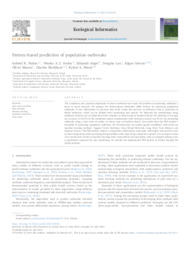Pattern-based prediction of population outbreaks.
Pattern-based prediction of population outbreaks.
Author(s): PALMA, G. R.; GODOY, W. A. C.; ENGEL, E.; LAU, D.; GALVAN, E.; MASON, O.; MARKHAM, C.; MORAL, R. A.
Summary: Resumo: A complexidade e a importância prática dos surtos de insetos tornaram o problema de prever surtos um foco de pesquisa recente. Propomos o método de Previsão Baseada em Padrões (PBP) para prever surtos populacionais. Este método usa informações sobre valores de séries temporais anteriores que precedem um evento de surto como preditores de surtos futuros, o que pode ser útil ao monitorar espécies de pragas. Nós ilustramos o método usando conjuntos de dados simulados e uma série temporal de pulgões obtida em lavouras de trigo no sul do Brasil. Abstract: The complexity and practical importance of insect outbreaks have made the problem of predicting outbreaks a focus of recent research. We propose the Pattern-Based Prediction (PBP) method for predicting population outbreaks. It uses information on previous time series values that precede an outbreak event as predictors of future outbreaks, which can be helpful when monitoring pest species. We illustrate the methodology using simulated datasets and an aphid time series obtained in wheat crops in Southern Brazil. We obtained an average test accuracy of 84.6% in the simulation studies implemented with stochastic models and 95.0% for predicting outbreaks using a time series of aphids in wheat crops in Southern Brazil. Our results show the PBP method's feasibility in predicting population outbreaks. We benchmarked our results against established state-of-the-art machine learning methods: Support Vector Machines, Deep Neural Networks, Long Short Term Memory and Random Forests. The PBP method yielded a competitive performance associated with higher true-positive rates in most comparisons while providing interpretability rather than being a black-box method. It is an improvement over current state-of-the-art machine learning tools, especially by non-specialists, such as ecologists aiming to use a quantitative approach for pest monitoring. We provide the implemented PBP method in Python through the pypbp package.
Publication year: 2023
Types of publication: Journal article
Unit: Embrapa Wheat
Keywords: Afídeo, Alert zone procedure, Aprendizado de máquina, Deep learning, Dinâmica Populacional, Epidemiologia, Lavoura, Machine learning, Monitoramento de pragas, Population dynamics, Praga de Planta, Sistemas alerta, Sistemas de Suporte à Tomada de Decisão, Séries Temporais, Time series, Time series analysis, Trigo, Wheat
Observation
Some of Embrapa's publications are published as ePub files. To read them, use or download one of the following free software options to your computer or mobile device. Android: Google Play Books; IOS: iBooks; Windows and Linux: Calibre.
Access other publications
Access the Agricultural Research Database (BDPA) to consult Embrapa's full library collection and records.
Visit Embrapa Bookstore to purchase books and other publications sold by Embrapa.

